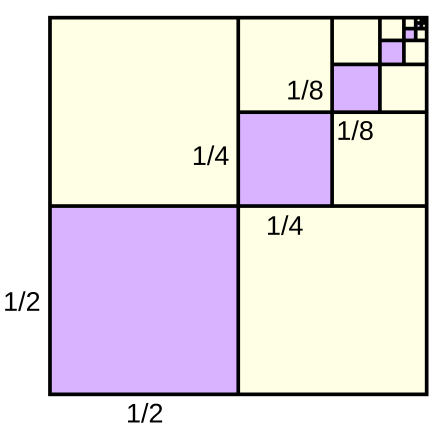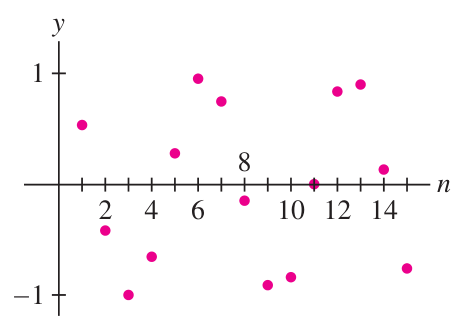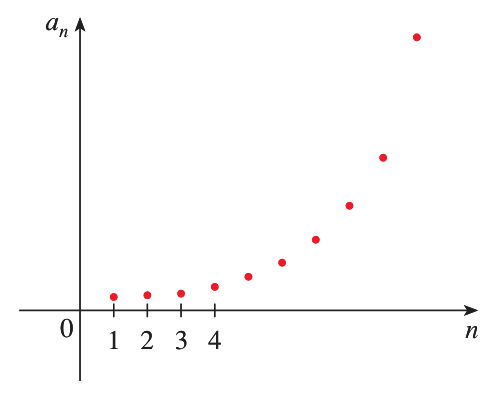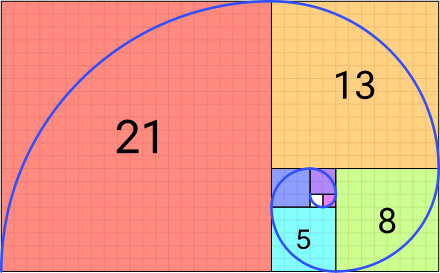Sequences
Videos, Math Dr. Bob:
- Infinite sequences: Definition; Squeeze Theorem
- Extra: Infinite sequences: Various examples, arithmetic and geometric
- Extra: Infinite sequences: Recursive sequences (like Fibonacci)
01 Theory
A sequence is a rule that defines a term for each natural number
So a sequence is a function from
Geometric sequence
A sequence is called geometric if the ratio of consecutive terms is some constant
, independent of :
The defining relation of a geometric sequence is equivalent to
By plugging
Therefore

Starting point of a sequence
Note that sometimes the index (variable) of a sequence starts somewhere other than
. Most common is but any other starting point is allowed, even negative numbers. Sometimes
is used instead of in the formula for the general term of a sequence, thus . The ‘ ’ notation is useful when the sequence starts from .
Extra - Fibonacci sequence
The Fibonacci sequence goes like this:
The pattern is:
This formula is a recursion relation, which means that terms are defined using the values of prior terms.
The Fibonacci sequence is perhaps the most famous sequence of all time. It is related to the Golden Ratio and the Golden Spiral:
02 Illustration
Geometric sequence: revealing the format
Geometric sequence: revealing the format
Find
and and (written in the geometric sequence format) for the following geometric sequences: (a)
(b) (c) Solution (a) Plug in
to obtain . Notice that and so therefore . Then the ‘general term’ is . (b) Rewrite the fraction:
Plug that in and observe
. From this format we can read off and . (c) Rewrite:
From this format we can read off
Link to originaland .
Series
Videos, Math Dr. Bob:
- Infinite series: Definitions, basic examples
- Geometric series and SDT: Geometric series, Simple Divergence Test (aka “Limit Test”)
- Infinite series: Various examples
- Extra: Infinite series convergence: Telescoping series
03 Theory
A series is an infinite sum that is created by successive additions without end. The terms are not added up “all at once” but rather they are added up “as
Three of the most famous series are the Leibniz series and the geometric series:
Partial sum sequence of a series
The partial sum sequence of a series is the sequence whose terms are the sums up to the given index:
These
terms themselves form a sequence:
04 Illustration
Example - Geometric series
Geometric series - total sum and partial sums
The geometric series total sum
can be calculated using a “shift technique” as follows:
- Compare
and : - Subtract second line from first line, many cancellations:
- Solve to find
: Note: this calculation assumes that
exists, i.e. that the series converges. The geometric series partial sums can be calculated similarly, as follows:
- Compare
and : - Subtract second line from first line, many cancellations:
- Solve to find
: Link to original
- The last formula is revealing in its own way. Here is what it means in terms of terms:
Convergence
Videos, Math Dr. Bob:
- Infinite sequences convergence: Squeeze; Monotone Bounded
- Infinite sequences convergence: Examples sequences: convergent, monotonic, bounded
05 Theory
A sequence has a limit if its terms tend toward a specific number, or toward 
When this happens we can write “
The sequence is said to converge if it has a finite limit
Some sequences don’t have a limit at all, like

Or

These sequences diverge.
In the second case, there is a limit
The difference between converging and having a limit is that a limit could ‘exist’, namely at
or , yet we still say the sequence diverges.
Extra - Convergence definition
The precise meaning of convergence is this. We have
as if, given any proposed error , it is possible to find such that for all we have . When
, convergence means that given any , we can find such that for all we have . Similarly for
.
If the general term
If
06 Illustration
L’Hopital’s Rule for sequence limits
L’Hopital’s Rule for sequence limits
(a) What is the limit of
? (b) What is the limit of ? (c) What is the limit of ? Solution (a) Identify indeterminate form
. Change from to and apply L’Hopital: (b) Identify indeterminate form
. Change from to and apply L’Hopital: (c) Identify form
and rewrite as : Change from
to and apply L’Hopital: Simplify:
Consider the limit:
Link to original
Extra - Squeeze theorem
Squeeze theorem
Use the squeeze theorem to show that
as . Solution We will squeeze the given general term above
and below a sequence that we must devise: We need
to satisfy and . Let us study . Now for the trick. Collect factors in the middle bunch:
Each factor in the middle bunch is
so the entire middle bunch is . Therefore: Now we can easily see that
Link to originalas , so we set and we are done.
07 Theory
Monotone sequences
A sequence is called monotone increasing if
for every . A sequence is called monotone decreasing if
for every .
In this context, ‘monotone’ just means it preserves the increasing or decreasing modality for all terms.
Monotonicity Theorem
If a sequence is monotone increasing, and bounded above by
, then it must converge to some limit , and . If a sequence is monotone decreasing, and bounded below by
, then it must converge to some limit , and .
Terminology:
- Bounded above by
means that for every - Bounded below by
means that for every
Notice!
The Monotonicity Theorem says that a limit
exists, but it does not provide the limit value.
08 Illustration
Monotonicity theorem
Monotonicity
Show that
converges. Solution
Observe that
for all . Because
, we know . Therefore
Change
to and show is decreasing. New formula:
considered as a differentiable function. Take derivative to show decreasing.
Derivative of
: Simplify:
Denominator is
. Numerator is . So and is monotone decreasing. Therefore
Link to originalis monotone decreasing as .
09 Theory
Series convergence
We say that a series converges when its partial sum sequence converges:
Let us apply this to the geometric series. Recall our formula for the partial sums:
Rewrite this formula:
Now take the limit as
So we see that
converges exactly when . It converges to .
(If
Furthermore, we have the limit value:
This result confirms the formula we derived for the total
Extra - Aspects of
and from the geometric series Notice that we always have the rule:
This rule can be viewed as coming from partitioning the full series into a finite part
and the remaining infinite part: We can remove a factor
from the infinite part: The parenthetical expression is equal to
, so we have the formula given above.
